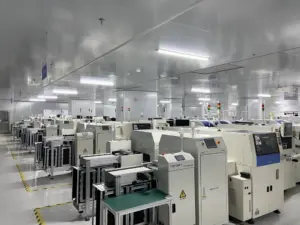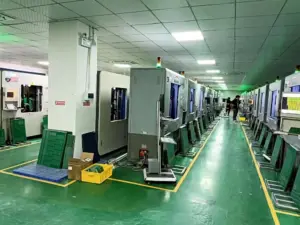Einführung
The SMT line has become admirable today, specifically in the electronics industry.
It’s known for attributes like increased automation and excellent quality. It has become the leading PCB assembly line, replacing the traditional through-hole technology (THT).
But what exactly is an SMT line? How is this process carried out, and what are its main elements? What are its advantages?
Keep reading as this article will look at all the aspects of SMT assembly line in detail.
What is an SMT Line?

You may know that SMT is short for Surface-Mount Technology. The process mounts electronic components onto the Printed Circuit Board surface. The electronic components can include capacitors and transistors.
SMT allows the production of electronic boards with high speed and precision. It’s an automatic process.
An SMT line is also called an SMT production line. It refers to the high-tech production facilities for PCB assembly and testing via the SMT.
Such a process comprises many integrated machines operating together. The goal is to assemble electronic components onto boards with greater precision and speed. The process is typically optimized for large volumes of electronics manufacturing.
Comparison of SMT (Surface Mount Technology) with THT (Through-Hole Technology)
SMT stands for Surface Mount Technology. It was invented by IBM in 1960. Since then, it has become common to be applicable in high-tech PCB assembly.
The electronic device for which the components are mounted onto the PCB is called SMD. SMD stands for Surface Mount Device.
Today, SMT has widely replaced the old through-hole technology (THT). The latter involves manually fitting components with wire leads into holes drilled in the PCB, followed by soldering.
The components suitable for an SMT line are typically smaller. Meanwhile, the THT components are typically larger and bulkier.
What are the advantages of an SMT line?
An SMT line has several advantages over traditional PCB assembly procedures. Here are some prominent ones:
1. Speedier and more efficient process
You may know by now that SMT manufacturing is an automated process. It allows for speedier and more efficient production. Particularly, the use of a pick-and-place machine helps to meet this goal.
2. High Component Density
An SMT assembly line allows for high component density on boards. The reason is that the component is mounted directly onto the Printed Circuit Board’s surface. Thus, a myriad of compact and miniature devices make up modern electronics. Examples include wearables and smartphones.
Such high compact density makes the end products smaller in size and weight. It’s ideal for devices with limited space.
3. Less manual labour
There is a need for less manual labour in an SMT line. In contrast, the old assembly procedures require more manual labour. It can be time-consuming and can bring about faults.
4. Cost-effectiveness
An SMT line can result in cost-effectiveness and savings and decrease the total production cost. The following are some reasons for it:
- less manual labour costs
- speedier assembly process
- wastage of lesser materials
5. Greater automation
You can see that SMT manufacturing is more automatic than the THT assembly procedure. The equipment used in SMT manufacturing is mostly fully automated and involves no manual handling. It can greatly enhance production efficiency and make the process more reliable.
6. SMT processes are compatible with advanced technologies
SMT assembly processes work well with advanced technologies like Ball Grid Array packages. It aims to produce the latest high-tech devices.
- More environmentally friendly
An SMT production line is more environmentally friendly than traditional PCB assembly processes.
There is less energy consumed and less waste of harmful materials. Furthermore, less solder is utilized in SMT manufacturing.
SMT Assembly Line Process
You now know the advantages of an SMT production line. Let’s provide insight into the essential steps of the process. These are:
1. Preparing and checking materials (by QC Department)
Firstly, QC inspectors carefully check the boards and SMT components for quantity and quality. If any flaws are detected in the materials, they are picked out.
Note that the boards are flat at this stage and have solder pads.
2. Solder Paste Printing
The next step in the SMT assembly line is solder paste printing. Here, solder paste is applied to the surface of the pads via automatic screen printers. It’s done via the stencil and the squeegee (a tool that cleans in printing).
Solder paste is a blend of flux and powdered solder alloy. The flux acts as an adhesive. Its purpose is to ensure that the surface mount components stay in place until soldering. It also protects the soldering surface from oxidation and impurities.
The solder paste connects the components and solder pads on the board.
3. Inspection of Solder Paste
Next, an optical inspection machine is used to check the quality of applied solder paste. It evaluates the accuracy and volume of the applied solder paste deposits on the board contact pads. It also checks for other defects.
4. Component placement
Next, the boards with solder paste on the contact pads go through a pick-and-place machine. It picks and places components on the board.
It’s a significant step because accuracy should be maintained during this process. Otherwise, any error in placement can be costly, and you will need time to resume work.
5. Reflow soldering
The Printed Circuit Boards with installed electronic components exit the pick-and-place machine. They move via the conveyer to the reflow oven. Here, they go through the soldering process.
The reflow oven has different zones. Each zone has varying temperature control. It ensures the boards are heated and cooled according to the pre-set program.
6. Inspection after soldering
After soldering, an AOI (automatic optical inspection) machine checks the boards for quality. If any flaws are detected, they are corrected, and then the product is stored.
The AOI machine checks different aspects, such as components’ absence and solder connections’ quality. As stated earlier, an X-ray inspection machine can also be used.
7. QC of finished PCBs
The finished PCBs undergo checking through the process of FQC (Final Quality Control). The inspected PCBs are packaged. They are then moved to the warehouse for delivery to the customer.
SMT Line Layout Types
You can see that there are different types of SMT line layouts. Each layout enhances varying factors of the SMT process, like throughput and flexibility. Here are some prominent ones:
1. Linear Layout
The linear layout is also known as the in-line layout. Here, the machines and the working space are arranged in a linear form. The boards pass in a straight line in the varying phases of the assembly process.
It makes the layout straightforward and compact. It’s ideal for small-scale SMT processes. However, it offers less flexibility when treating boards of different sizes and structures.
2. L-Shaped Layout
In this layout, the working area and the machines form an L-shape. This arrangement is suitable with limited space and makes worthwhile use of the supplied area.
This layout can be worthy of carrying the assembly process in high volume.
3. U-shaped Layout
The machines and working space are in a U-shape arrangement in this arrangement. This layout is more flexible for operating boards of different sizes and structures. With this layout, operators can easily manage the assembly process with good clarity.
This layout also allows the working space to be used efficiently and enhances productivity.
4. Turret Layout
Turret layout is better known as star arrangement. It provides high-speed production.
Here, the pick-and-place machine lies in the centre. The other machines and working space are arranged in star-like or circular patterns around it. This arrangement provides an efficient flow of material from the central machine.
5. Dual-Lane Layout
Dual-lane layout is another prominent SMT process layout. It comes in two parallel line forms for the boards to pass through the process. This layout increases manufacturing productivity and features as two boards can be processed simultaneously.
Thus, a dual-lane layout is ideal for the SMT assembly process in high volumes.
6. Mixed layout
A mixed layout is made of different parts in different arrangement types. For example, there can be a U-shaped layout for the pick-and-place machine. However, there can be an in-line layout for the procedures involving inspection and soldering.
It can improve and enhance particular production parameters. It’s also known as a hybrid layout.
What are the Main Elements of an SMT line?

An SMT line comprises varying elements or machines. These elements assemble components for printed circuit boards. They work collectively to ensure effective and efficient production.
Such process can vary depending on the application and the automation level. However, it commonly comprises the following elements:
1. Stencil Printer
The stencil printer applies the solder paste on the blank PCBs.
The stencil has openings in accordance with the solder pads on boards. Solder paste is applied via these openings.
2. Pick-and-Place machine
It’s the most significant element in the SMT production line. It removes surface-mount components from reels, trays, or tubes and accurately places them on the PCB pads.
Currently, such machines can handle electronic components of different sizes and types. They are incredibly automated.
3. SMT Loader
SMT loader automatically places the boards onto the rack of the solder printing machine.
4. Conveyor system
The conveyor system is also an important element. It ensures that the boards accurately move through each process and reflow over. It allows for a continual flow of processes.
5. Reflow Oven
This machine allows electronic components to be soldered on boards. Here, the boards, solder paste, and components undergo a regulated heating process.
The outcome is that the solder paste melts and forms strong and reliable solder joints.
6. SPI (Solder Paste Inspection) Machine
The SPI machine inspects the area, thickness and volume of solder paste deposited on boards. It aids in finding issues like misalignment. It also aids in enhancing solder joint quality.
7. AOI (Automated Optical Inspection) and AXI (Automated X-ray Inspection) machines
AOI machines detect the electronic component’s configuration when connected on board. These machines are utilized before and after reflow soldering.
Similarly, AXI machines perform the same function. The difference is that AOI uses a camera to detect any errors. AXI machines use X-rays to check hidden joints.
8. SMT Unloader
SMT unloader receives and stores completed Printed Circuit Boards after manufacturing.
9. Software systems
Software systems are also part of the SMT production line. These regulate the programming of various machines, like a reflow oven. They also help to manage data related to manufacturing and assist with process improvement.
Why does Kingsun PCB need an SMT line?
Currently, Kingsun PCB provides low-volume Printed Circuit Board design and production. However, our need for complex and high-volume PCB production will continue to grow. An SMT line allows us to expand our capabilities in this sector.
At present, our PCB production has top-class equipment and ideal quality control. We have extensive experience in high-quality and efficient PCB assembly. Highly skilled engineers support us.
Having an SMT line will further make us develop and provide quality PCB assembly services.
Abschluss
By now, you must have understood why the SMT line is prevalent in the electronics industry.
It’s a high-tech production facility where electronic components are placed onto PCBs. It has several advantages, such as increased automation, cost-effectiveness, and a more efficient production process.
We also examined an SMT assembly line’s essential elements and layouts and described how such a process is carried out.
We hope this article will provide you with all the info about an SMT line.
